by pmdavis | Mar 27, 2015
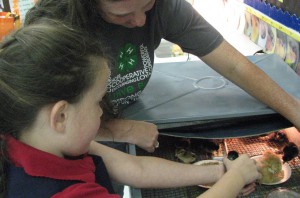 It’s almost Easter when lots of people think about those cute little chicks. Before you take on one of those cute little animals– let’s talk about the responsibilities and considerations when raising chickens
It’s almost Easter when lots of people think about those cute little chicks. Before you take on one of those cute little animals– let’s talk about the responsibilities and considerations when raising chickens
Keeping chickens isn’t much different than keeping pets – they need to be fed and watered every day and, yes, you have to deal with poop. However, most local veterinarians won’t check chickens, so you’ll also need to monitor your birds to know if a health intervention is needed. Handling and socializing your chickens from an early age makes it easier to get them to cooperate, but it also makes it more fun for you to enjoy their antics and unique personalities. If you’re thinking about getting chickens, the first thing to ask yourself is “why?” For human food production, self-sufficiency, selling eggs, entertainment, education for kids or simply as pets? Owning chickens can be all of these 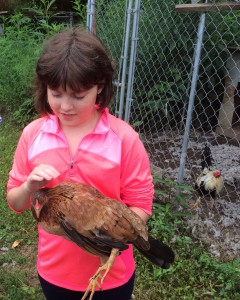 things. Your “why” will help you determine how much you want to invest, as well as guide you to what kind of chickens and coop you will need.
things. Your “why” will help you determine how much you want to invest, as well as guide you to what kind of chickens and coop you will need.
Everything from a few backyard chickens to 4-H projects and farms with several hundred chickens can be considered “small”. Just because a flock is small, does not mean that stewardship, efficient production, safe handling, and other rules can be ignored. Keeping a small flock of chickens for home use, a practice commonplace during our grandparents’ time, is becoming popular again. If you are considering this, you will need to educate yourself about poultry feeding, health and egg production, as well as food safety. There are many University publications on the web.
The University of Florida’s Institute of Food and Agricultural Sciences Extension has several articles on keeping chickens. UF/IFAS Extension has a section devoted to backyard poultry , Basic Guide for the Backyard Chicken Flock, which includes information about brooding, housing, feeding and nesting needs of birds. Other sites include: Escambia County Backyard Poultry Guide and Urban Farming Chickens 101. Other universities with excellent Extension resources to help with backyard poultry include: Mississippi State; Penn State; Purdue Extension; Colorado State Extension; a University of Minnesota and The University of Illinois Extension lists 33 resources on poultry. Another useful site is Illini PoultryNet.
Taking care of the chicks provides a fun way for kids to develop a sense of responsibility, while teaching them work ethics and healthy eating habits. Other ways your children could participate in 4-H and learn about poultry include: The 4-H & Farm Bureau Ag-in-the Classroom Embryology School Enrichment program offered in many counties. There are other activities that youth can engage in including poultry production, judging of poultry and poultry products, preparing foods using poultry and public presentations to inform others about chickens and poultry. Youth can compete in activities at the county, district, state and national levels. 4-H is one of the nation’s most diverse organizations and includes people from all economic, racial, social, political, and geographic categories. There are no barriers to participation by any young person. Participants are given the opportunity to engage in activities that hold their personal interest, while being guided by adult volunteers. The local 4-H Agent is a youth development professional who provides direction and program leadership as part of the nationwide Cooperative Extension System. For more information, contact your local UF/IFAS Extension Office or check out our web-site.
by pmdavis | Jan 5, 2015
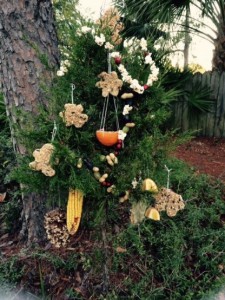
While youth are home over winter break, encourage them to do something fun that will attract wildlife. Nothing is more fun than watching birds or squirrels play in your yard. One way to make this happen is to provide a supplemental food source for them. You can create a special “Tree for Wildlife” in your yard. In fact, a great family activity is making some very inexpensive simple feeders. The most wonderful part is these feeders, they not only look attractive, but help wildlife survive through the winter.
You can create feeders out of bread, bird seed and a binding agent like eggs, lard or peanut butter. Cut stale bread into shapes with cookie cutters. Make a small hole in the top to put twine or string through. If using egg, brush the bread with egg wash and dip in seeds. Then let it dry for a day or so. Attach string and hang in the trees. If using lard or peanut butter, toast the bread to dry it out then spread like you would on a sandwich and roll in bird seed.
Another type of feeder that is popular especially if you have lots of pine trees are pine cone bird feeders. Attach string to a pine cone. Mix peanut butter and oats together then apply to pine cone. After the cone is covered with the mixture roll in bird seed. Lard can be used in place of peanut butter. Hang from tree.
One last type of feeder is using apple and orange slices. Cut thin slices of apples and oranges, attach string and hang each slice separately all around the tree.
Additional feeders could be strings of grapes, raisins, cranberries, raw peanuts, salt free crackers or popcorn. If you are using popcorn be sure it does not have butter and salt. Just use a needle and thread to make the strings. All edible decorations should be hung with biodegradable materials such as cotton string, twine, or thread.
For more information to help you invite wildlife into your yard check out Junior Master Gardener: Wildlife Gardener or Cornell Feeder Watch. Inviting wildlife into your yard provides a fun way for kids to develop a culture to care about nature, while teaching them about their environment. It also makes a great family traditional activity to do not only during the holiday season but throughout the year. 4-H is one of the nation’s most diverse organizations and includes people from all economic, racial, social, political, and geographic categories. There are no barriers to participation by any young person. Participants are given the opportunity to engage in activities that hold their personal interest, while being guided by adult volunteers. The local 4-H Agent is a youth development professional who provides direction and program leadership as part of the nationwide Cooperative Extension System. For more information, contact UF/IFAS Extension at http://florida4h.org/
.
by pmdavis | Nov 25, 2013
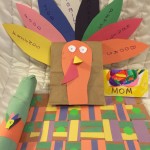 Thanksgiving is a time of family traditions, reflection and thankfulness! Remember to include children in the planning and preparation. In 4-H, we stress learn by doing and want to encourage you to consider that motto. Children love being included that inspires their creativity, imagination and sense of belonging. Being involved teaches life skills, such as measuring, meal preparation, teamwork, design and relationship building.
Thanksgiving is a time of family traditions, reflection and thankfulness! Remember to include children in the planning and preparation. In 4-H, we stress learn by doing and want to encourage you to consider that motto. Children love being included that inspires their creativity, imagination and sense of belonging. Being involved teaches life skills, such as measuring, meal preparation, teamwork, design and relationship building.
Some ways to involve children are very simple! Have them help shop or find bargains with a Thanksgiving Scavenger Hunt. Give each child a list of grocery products to find. They will have fun locating items at the store or finding the best buys in advertisements. Older kids can clip coupons.
Make simple inexpensive decorations. Create turkey hand or leaf wall hangings, wreaths, a tree of thanks, clay or play dough holiday ornaments, centerpieces, placemats, name cards, napkin rings. Napkin rings can be made out of cut paper towel rolls or construction paper glued in a circle and decorated with artwork, fabric, leaves or even feathers. Guests will admire these items while enjoying the meal.
To help the day go smoothly, consider your needs and home size. For example, if you have a small kitchen let them help you prepare items ahead of time for the meal i.e cranberry salad. Consider having older youth select a recipe to be the lead chef. Doing a trial run prior to the holiday meal. Kids can easily help: wash fruits and vegetables, snap green beans, crack eggs, stir cake batter, roll out pie crusts, mash potatoes, sprinkling marshmallows or put relish items on a tray.
Let kids set the table. Make the task simple by using printable table-setting cheat sheet, showing where items should be placed. Have kids count out the number of place-mats, name cards and napkin rings needed.
Other traditions to consider include:
- 1. Create a turkey of thanks. Have children cut paper feathers and place them at each place setting. When everyone sits down to eat, have them write one thing they are thankful for. Create a paper turkey centerpiece by passing a paper bag and glue stick letting each person glue on their feather telling why they are thankful.
- 2. Make a family trivia game. Have children ask each person to write down trivia questions about events that happened during the year, or family history. Collect the questions and give out small prizes for each correct answer.
- 3. Play the A to Z family gratitude game. Have everyone sit together and each person says what they’re grateful for, according the letter of the alphabet the player is up to.
- 4. Read a book about Thanksgiving to help children learn the meaning of Thanksgiving.
- 5. Help someone less fortunate or in poor health by serving meals, raking leaves, taking a plate of food.
Sounds simple, and in all reality it is. Adults give guidance to children helping them identify and feel good the positive things in their lives. The trick is to relax, plan and enjoy the holiday together. One web page that gives lots ideas for holiday decorations the family can do together http://aboutfamilycrafts.com/30-turkey-crafts-for-kids/. All Extension programs are open to all persons regardless of race, color, age, sex, handicap or national origin.
by pmdavis | Oct 25, 2013
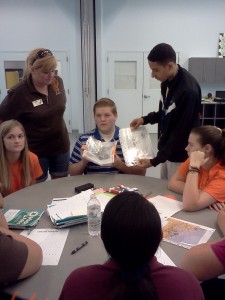
Looking at two different plans designed by group
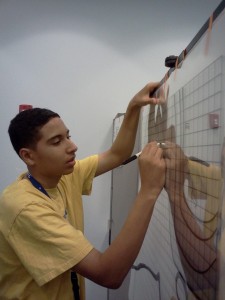
Drawing a map layer
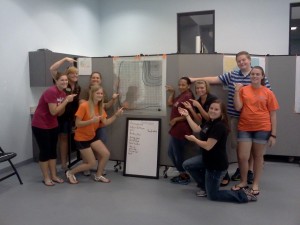
Teens and staff training to teach NYSD Material
October 6-12 was National 4-H Week, and more than 6 million young people across the country celebrated the great things that the 4-H youth development program offers young people and the incredible 4-H’ers who work each day to a make a positive impact on their community.
One of the highlights of National 4-H Week has become the 4-H National Youth Science Day (NYSD). For more than 100 years, 4-H has been at the forefront of teaching young people about science, technology, engineering and math (STEM). Currently, more than five million young people across the nation participate in 4-H STEM programming in topics as varied as robotics, agricultural science, rocketry, wind power, environmental science and alternative energy. NYSD is the premier national rallying event for this year-round 4-H STEM programming, bringing together youth, volunteers, and educators from the nation’s 109 land-grant colleges and universities to simultaneously complete the National Science Experiment.
Wednesday, October 9, 2013, was the official date of the sixth annual 4-H NYSD, and as a part of National 4-H Week, millions of young people became scientists for the day. This event, which takes place in urban, suburban and rural communities all across the nation, seeks to spark an early youth interest and leadership in STEM careers in an effort keep America competitive in those fields.
The 2013 NYSD Experiment is – 4-H Maps & Apps! This set of activities turns young people into geospatial thinkers as they design and map their ideal park, use GIS mapping to solve community problems, and contribute data about their community to the United States Geological Survey.
Research has proven that participation in 4-H has a significant positive impact on young people. Recent findings from the Tufts University 4-H Study of Positive Youth Development indicates that, when compared to their peers, young people in 4-H are:
- Nearly 4 times more likely to contribute to their communities,
- Two times more likely to pursue healthy behaviors, and
- Two times more likely to engage in Science, Technology, Engineering and Math (STEM) programs in the out-of-school time.
National Youth Science Day is just one of the many ways we reach youth to make these kinds of impacts. If you would like more information on 4-H National Youth Science Day or would still like to participate in the activity, there is still time. Information is available at http://www.4-h.org/4-h-national-youth-science-day/. It’s not too late to plan and register your event for 2013!
by pmdavis | Aug 2, 2013
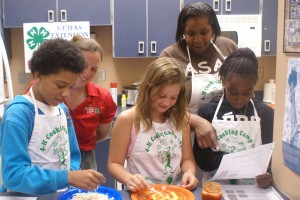 4-H and Foods, sounds pretty yummy to me! In fact cooking projects are a great example of how youth learn about foods by partnering with adults in the kitchen to plan and prepare them. Most 4-H cooking projects explore the science, nutrition and history of cooking while promoting healthy eating and resource management.
4-H and Foods, sounds pretty yummy to me! In fact cooking projects are a great example of how youth learn about foods by partnering with adults in the kitchen to plan and prepare them. Most 4-H cooking projects explore the science, nutrition and history of cooking while promoting healthy eating and resource management.
As an adult partner you will help youth learn how to select, prepare and store food items. You can help them explore the many methods of cooking, which include roasting, stir frying, grilling, barbecuing, smoking, boiling, steaming, braising and microwaving. The USDA’s MyPlate (http://www.choosemyplate.gov/) can help you to plan meals and make balanced food choices.
Remember when cooking with kids safety is first. Have supervision. Never allow youth to cook without asking for permission. Remind youth that clean is good! Keep hands and surfaces clean, if the children you work with have long hair be sure to tie it up. Also be sure that they do not have loose clothing that can catch on fire. Help youth identify and know how to safely use common tools in the kitchen including knives and other sharp objects, hot items such as broiler, toaster, stove or microwave and teach them measuring methods. Remind youth to keep hot foods hot and cold foods cold. We certainly don’t want any of those food borne illnesses coming our way.
Help youth read the directions and follow the recipes. They should check to be sure that they have all of their ingredients before beginning their cooking project. If the project requires cutting skills start simple with something soft like a banana and a plastic knife. Demonstrate the technique then have them try the actions. Teach them the following rules for working with knives.
-
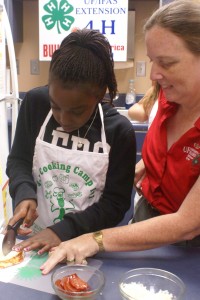
Paula and Nakobie cutting tortilla
Cut with caution.
- Focus on one task at a time.
- Never point a knife at a person.
- Always hold knife by handle.
- Use a cutting board.
- Go Slow. Take your time to learn how to cut. Beginners can start with sturdy plastic knives.
Remember to demonstrate how to wash produce and handle meat safely so you do not have cross contamination of foods. Help youth find what it is about cooking that excites them! There are recipes for snacks, side dishes, main dishes, quick breads and desserts that are great starters for youth cooking. Great projects to start with are the national 4-H Foods Curricula, or Florida Department of Agriculture Xtreme Cuisine, Nebraska 4-H has some easy kid friendly recipes or see the handout made by Bay County Extension about kid friendly foods.
 It’s almost Easter when lots of people think about those cute little chicks. Before you take on one of those cute little animals– let’s talk about the responsibilities and considerations when raising chickens
It’s almost Easter when lots of people think about those cute little chicks. Before you take on one of those cute little animals– let’s talk about the responsibilities and considerations when raising chickens things. Your “why” will help you determine how much you want to invest, as well as guide you to what kind of chickens and coop you will need.
things. Your “why” will help you determine how much you want to invest, as well as guide you to what kind of chickens and coop you will need.






